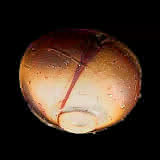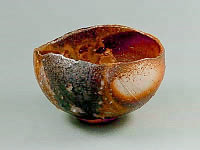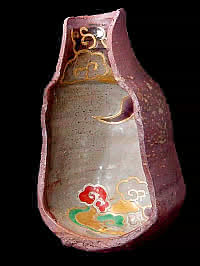|


Published by Yakimono.net April 2002

Cup by Kakurezaki Ryuichi
Pouring Bowl by Nakamura Takuo
Is it an Ofuke or a Hagi plate? I'd bet my last guinomi that most knowledgeable folks would undoubtedly say an Edo-period Ofuke plate. Yet, according to the book Yakimono Shin-Gan Kantei, these small pleated plates were also made in Hagi. It says that the Hagi plates look almost identical to the Ofuke ones and most folks can't tell the difference. I know that I can't so easily.

Hagi, Pleated Plate, Edo Period
So much to know in the Japanese yakimono world, especially when one gets into the vast array of wares in the Edo period. I thought the charming shape and pleasing glass-like glaze of the plate would make a perfect saucer for a guinomi (see above photo). It's easy to pick up due to the ridges around the edge. Plus the pleated sides are perfect for pouring any overflowing sake back into the guinomi.
 The rounded shape of this Bizen sakenomi (drinker's cup) by Kakurezaki Ryuichi sits nicely on the crackled glazed saucer. Kakurezaki fired this piece to perfection with its interesting keshiki (landscape) of a single red hidasuki line shooting across the back like a comet across the night sky. (Hidasuki means fire-cord marking, which is created by wrapping straw around the pot and burning it off in the kiln.) Various crispy brown tones envelop the cup; from a soft caramel color to a hazelnut shell brown, the coloration mixes in perfect harmony. On the front it gets a little too intense though with some dark scorch marks where the force of the flame licked the cup with its blackish tongue. Inside is a mesmerizing pool of tobi-goma (meaning "spotted flying goma;" goma here means "sesame-colored" natural ash glaze), one that glistens when sake is poured within. The lip is undulating and quite thin. The rounded shape of this Bizen sakenomi (drinker's cup) by Kakurezaki Ryuichi sits nicely on the crackled glazed saucer. Kakurezaki fired this piece to perfection with its interesting keshiki (landscape) of a single red hidasuki line shooting across the back like a comet across the night sky. (Hidasuki means fire-cord marking, which is created by wrapping straw around the pot and burning it off in the kiln.) Various crispy brown tones envelop the cup; from a soft caramel color to a hazelnut shell brown, the coloration mixes in perfect harmony. On the front it gets a little too intense though with some dark scorch marks where the force of the flame licked the cup with its blackish tongue. Inside is a mesmerizing pool of tobi-goma (meaning "spotted flying goma;" goma here means "sesame-colored" natural ash glaze), one that glistens when sake is poured within. The lip is undulating and quite thin.
 That thinness, or thickness, of a guinomi will change the flavor profile of the sake. With a thin-lipped cup the sake hits the front of one's tongue first where sweetness is detected. On a thick-lipped guinomi, the sake will flow to the back of the tongue first and this is where bitterness is detected. Kakurezaki's sakenomi is perfect for a slightly sweet sake, yet I much prefer a dry junmai myself! That thinness, or thickness, of a guinomi will change the flavor profile of the sake. With a thin-lipped cup the sake hits the front of one's tongue first where sweetness is detected. On a thick-lipped guinomi, the sake will flow to the back of the tongue first and this is where bitterness is detected. Kakurezaki's sakenomi is perfect for a slightly sweet sake, yet I much prefer a dry junmai myself!
The katakuchi (spouted serving bowl; see below photo) is from the kirei-sabi world of Kanazawa's Nakamura Takuo. Kirei-sabi is a term that may be loosely translated as "refined beauty." The dark muted earth tones on the outside are wonderfully balanced by the Rimpa-esque designs on the inside. It has an ethereal feeling and for some reason reminds me of a Buddhist funeral. Maybe that's just the spirituality contained within the work. Nakamura stamps much of his work with Baizan, the name of his kiln and father. His work is becoming world renowned and last year a Nakamura mizusashi (fresh water jar) found its way into the permanent collection of the Metropolitan Museum in NYC.
What an intriguing threesome here, incorporating many of the diverse aspects of the Japanese pottery world into a drinking pleasure realm.


LEARN MORE
|